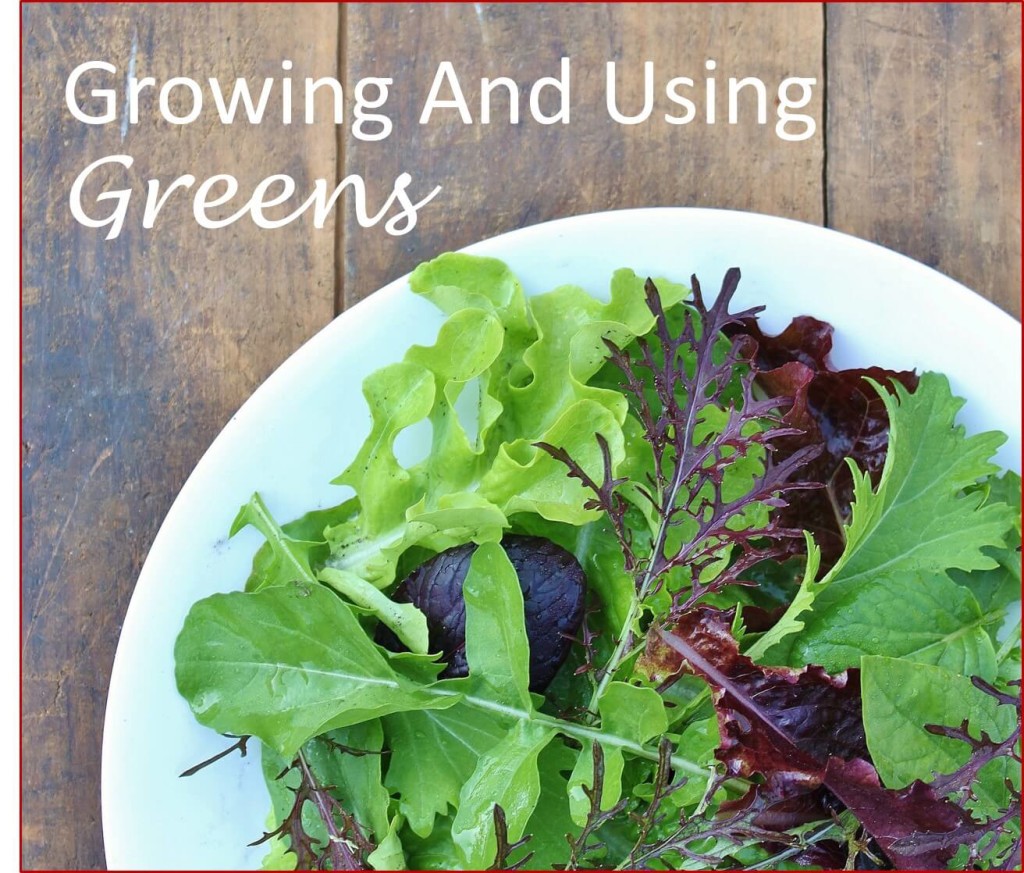
Grow a variety of types and colors of greens to make the most beautiful mesclun mixes, and delicious cooked greens.
Tomatoes, a few herbs, and occasionally peppers or cucumbers grew in our kitchen garden when I was a child. I don’t know why, but we never grew greens and we rarely ate any greens other than iceberg lettuce and spinach. I eventually acquired a taste for Romaine and butterhead lettuce, but didn’t appreciate other greens until we had rabbits. I grew quite a bit to satisfy their voracious vegetarian appetites, and began adding some of “their” greens to our own meals. We came to enjoy many different greens, which now appear regularly on the menu. We don’t have rabbits anymore, and may never want them again, but I’m glad they forced me to learn more about growing and using greens. I now grow greens for mesclun, other raw salads and slaws, and for cooked dishes.
If you grow greens in a greenhouse or on a sunny window sill, you can have home grown salad greens all year round. I don’t have a greenhouse and find the flavor of indoor grown greens rather bland for the trouble. This post is about how I grow a variety of greens for raw salads and for cooking, outdoors spring through fall.
Growing And Using Greens for Salads and Cooking
The most commonly grown greens in the home garden, are from three different plant families, and all are tolerant of at least light frost. Many also tend to bolt – to quickly bloom – in warm weather, at which point they become strong and bitter.
- Lettuce family
- Mustard family
- Beet family.
It’s relatively easy to produce an abundance of greens with few problems if you:
- Grow some from each family
- Inter-plant them with other crops
- Use them in a succession planting program.
Those practices create species and structural diversity within the garden, which help maintain balance and prevent pest outbreaks. Remember that plant diversity and structural diversity beget animal diversity. (“Animals” include birds, insects, soil invertebrates, and micro-organisms, not just furry critters.) Read more about the benefits of diversity in my post on Permaculture Principles.
There are other advantages to species diversity when growing greens: Beautiful mesclun mixes, more balanced nutrition, and a longer season of harvest.
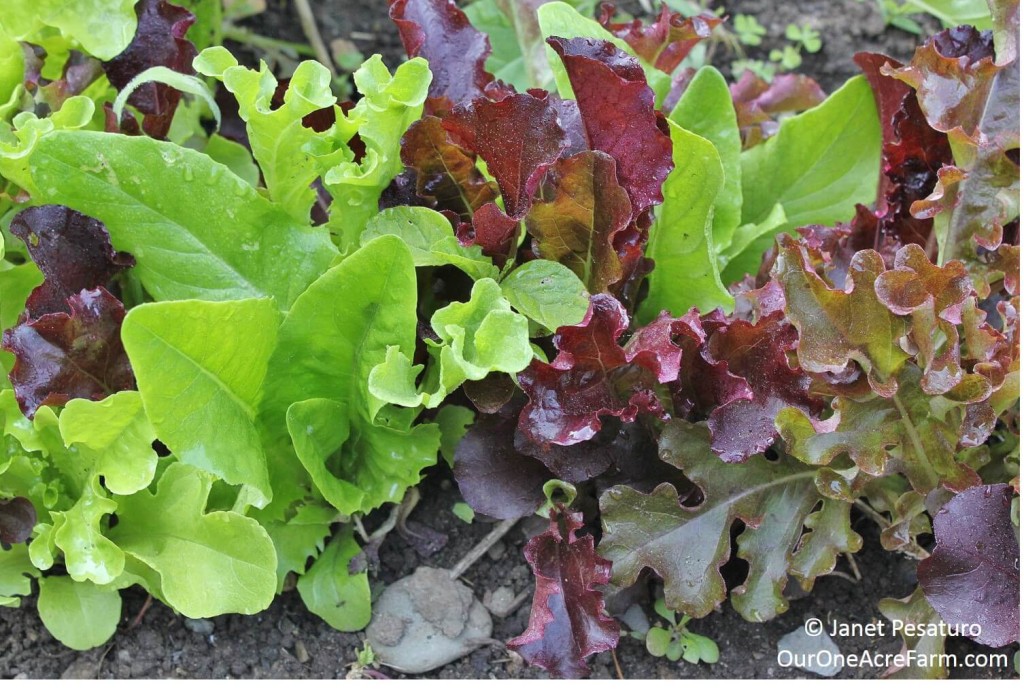
These gorgeous greens came from a mix of several varieties and colors of lettuces. Don’t be afraid to throw heading lettuces such as Romaine into your mix. You can treat them just like cut and come again lettuces.
Lettuce Family
Leaf lettuces, including oak leaf and lolla, come in a wide range of shapes, and they’re the classic lettuce for cut and come again salads. But I also treat the head lettuces, such as Romaine and butterhad, as cut and come again. I don’t let them head up, and I’m not sure why anyone does, unless they are selling the heads. As with the leaf lettuces, the outer leaves of Romain and butterhead can be harvested as they grow, and new leaves will continue to grow from the center. If you let them head up, all the heads are ready at once, and most families wouldn’t be able to use them all before flavor and texture deteriorate.

I harvest the outer leaves of butterhead lettuces (here inter-planted with carrots) in the same way cut and come again leaf lettuces are harvested.
For excellent variety in color, shape, and flavor, make or buy a lettuce seed mix which includes red and green varieties of several types of lettuces. Start some indoors for early transplanting, according to the packet directions. As soon as the soil can be worked, pop the transplants into the garden. If/when a hard frost or snow threatens, cover them. We use plastic gallon jugs, as shown in the photo. Once you’ve got your transplants in, direct seed a mix of lettuce seeds.
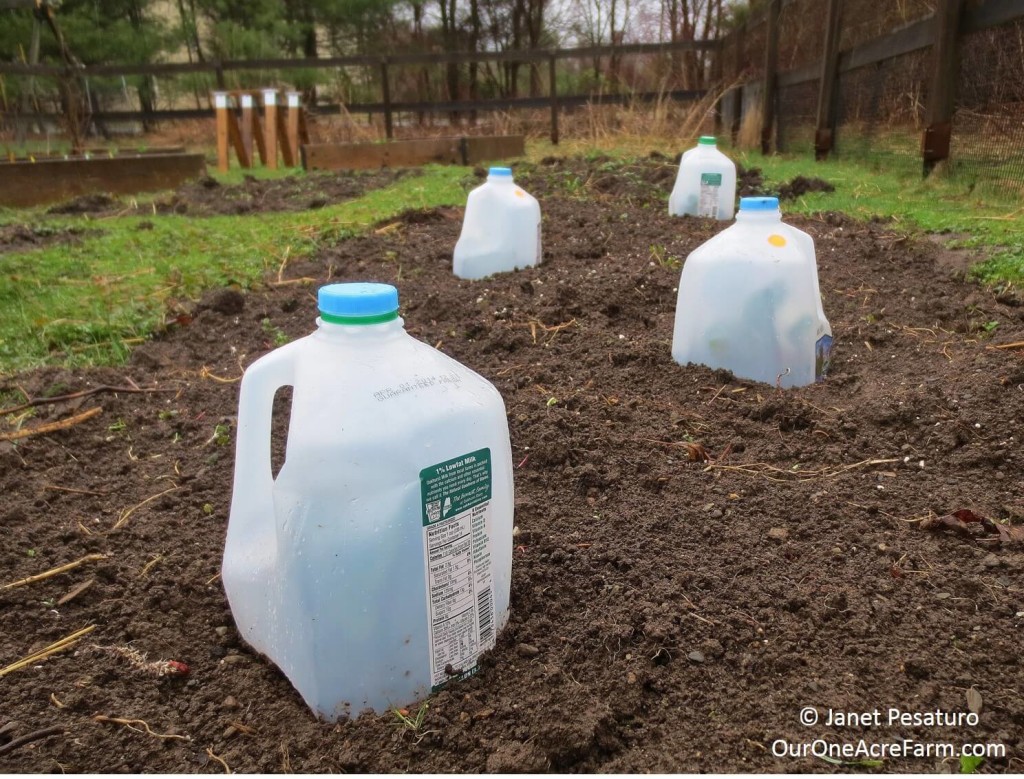
I set transplants out as early as possible, and cover with plastic gallon jugs (bottoms cut out) when snow or hard frost threatens.
Don’t mix seeds of the brassicas (mustard green family) with your lettuce seed mix, because the former germinate much more quickly, and out compete the lettuces.. Continue to sow your lettuce seed mix every 2 weeks or so, throughout spring.
To harvest, cut or pinch outer leaves at the base. You can harvest when plants are only a few inches tall, but be sure that several leaves are left on the plant, and be extra careful not to pull up that young root system. As the weather warms up, harvest the older plants aggressively, because they will soon become bitter and bolt. Flavor is best during cool weather, before a flower stalk forms. When they become bitter or shoot up a flower stalk, pull most of them up to make room for other crops. Let a few go to seed so you’ll have some volunteers next year.
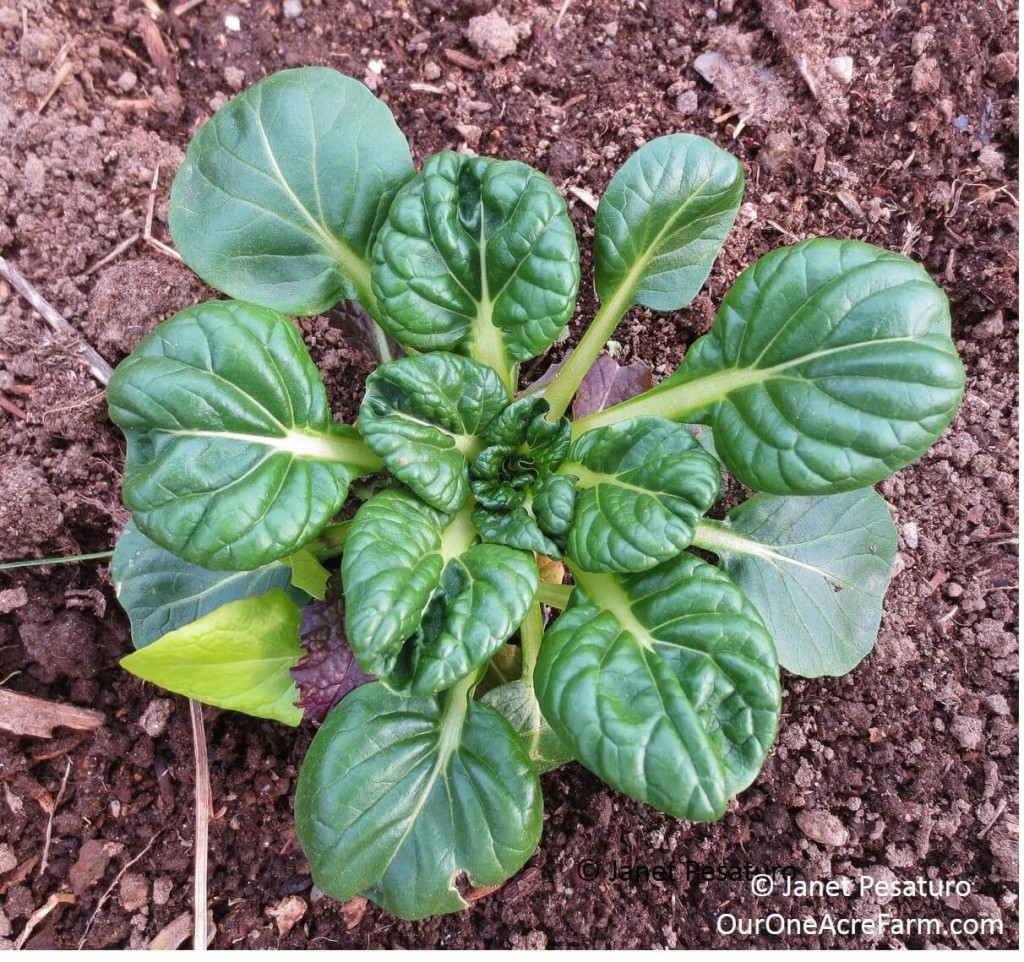
Tatsoi, an excellent addition to mesclun, is in the mustard family.
Mustard Family
These are the brassicas, and there are many species and varieties. Broccoli and cauliflower are brassicas, but for mesclun and other leafy dishes, you want mustard greens, Asian greens, kale, collards, arugula, turnip greens, etc.
1. Mustard Greens
A seed mix of at least four varieties ought to give you nice variation in shape, color, and flavor. For beautiful mesclun mixes, choose one with round green leaves (pac choi or tatsoi), another with round red leaves (e.g., Red Pac), a ruffly green leaf variety (e.g. Tokyo Bekana), and a frilly red leaf variety (Ruby Streaks or Scarlet Frills).
Buy transplants, or plant your own. Set transplants out with your lettuce transplants, as soon as soil can be worked, and protect if snow or hard frost threaten. About 7-10 days later (or 7-10 days after you seed your lettuces), direct seed the brassica mix, and continue to direct seed every 2 weeks or so, while weather remains cool. The reason for the 7-10 day delay is that mustards germinate more quickly than lettuces, and staggering the planting dates ensures that mustards and lettuces will be ready to pick at the same time.
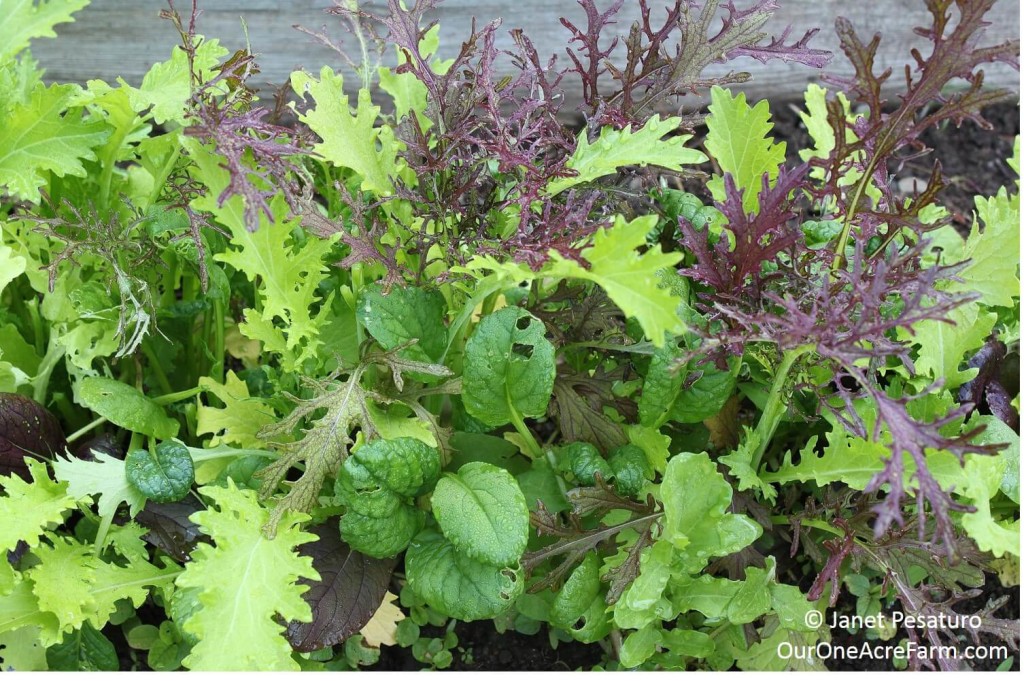
Buy ready made seed mixes, or have fun making your own. This mix of mustard greens contains a wonderful variety of shapes and colors. It’s almost too pretty to harvest.
Most mustard greens become unpleasantly strong as the weather warms up. Harvest as for lettuces, above. Harvest aggressively as weather warms, unless you like mature mustard greens, in which case you harvest more modestly, allowing the plant to mature. When leaves are too strong for raw salads, try Wild Mustard Greens with Dock. (Use any mustard greens – they don’t have to be wild. The dock is optional.) Let some plants go to seed for volunteers next year.
2. Arugula
For me, arugula is kind of like goat cheese. I thought it was disgusting the first time I tasted it. The second time it was OK, and after 3rd time I knew it would be a staple in my diet. Call it pungent, bitter, or spicy…I love it regardless. It’s in the brassica family, and can be added to your mustard green seed mix. But I use it alone, and direct seed arugula a couple of time after my last sowing of the other mustards. We like it’s flavor even after the weather warms up; it’s the only green we have when our tomatoes are ready.
Like the other mustards, arugula is super easy to grow. Direct seed it as soon as the soil can be worked, and every few weeks thereafter, if you like. Harvest aggressively in warm weather, because it bolts. I always let some go to seed so we’ll have some volunteers around the garden the following year.
Here are some recipes using arugula:
- Spinach and Arugula Salad With Pineapple Dressing
- Bolted Arugula Pesto
- Tacos with Arugula, Black Beans, and Pork
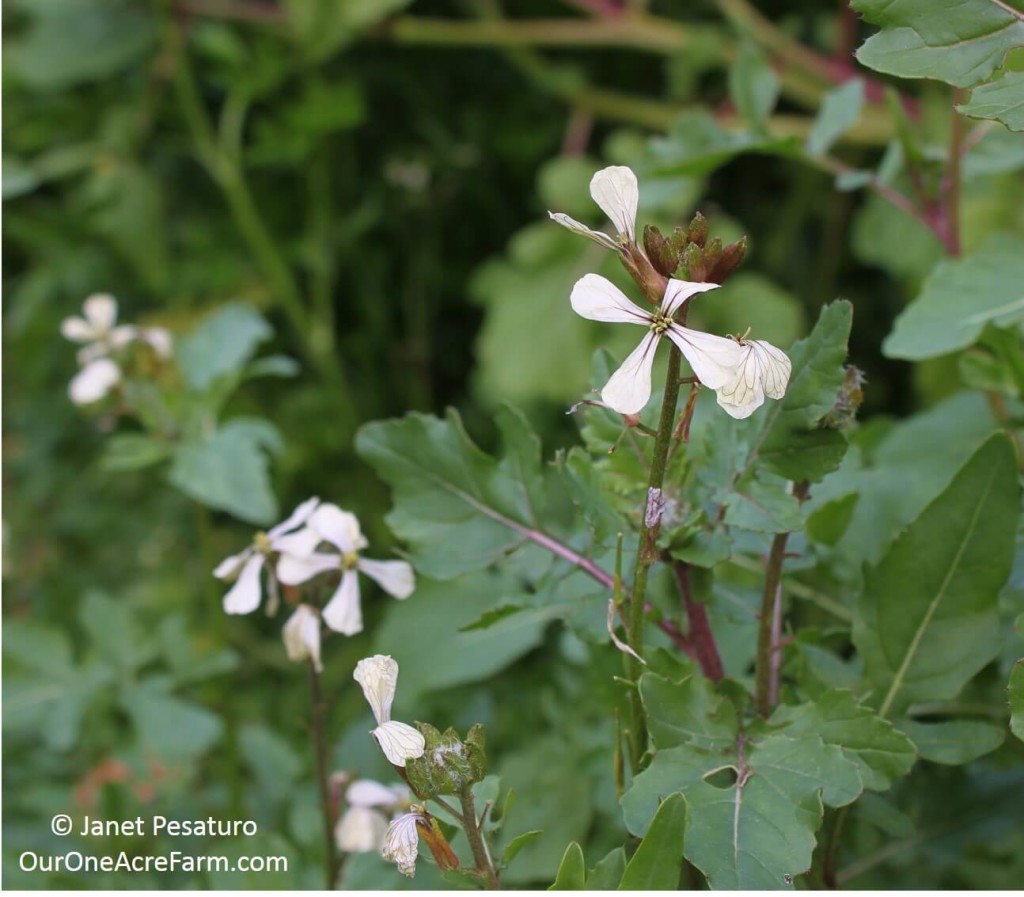
To make room for other crops, pull most of your greens when they begin to bolt, but if you want some volunteer seedlings, let a few bloom and go to seed, like this arugula.
3. Kale and Collards
These are brassicas, as well, but I plant them separately. Unlike the other mustard greens, kale and collards rarely bolt, and remain tasty all summer. I set my transplants out with the lettuce and other brassica transplants, but that’s it. I don’t direct seed kale or collards because these early transplants will yield through fall. The youngest leaves can be used in salads throughout spring, and even summer, if you don’t mind the toughening texture as the plant matures. Allow outer leaves and some inner leaves to mature. They are excellent in soups and stews. I actually like them raw in sandwiches well into the summer, and in slaws throughout the life of the plant. One of our favorites is Kale Salad with Maple Vinaigrette. For something simple and delicious, try Kale Chips.

This is Red Russian kale, my favorite kale for color, texture, and flavor.
4. Turnip Greens
Like most people, I grow this primarily for the root. But you need to thin the seedlings, and the leaves of young seedlings are an excellent addition to mesclun. They quickly become rough and tough, however, so thin your turnips when just a few inches tall. When you harvest the turnips, you can use the mature greens in cooking. They are tough and bitter, so cook them well, and use a sweetener and/or cook them with something really yummy, like bacon or ham.
Beet Family
Did you know beets, Swiss chard, and spinach are all in the same family? Maybe that’s not too surprising, but what about quinoa. Who knew that quinoa is in the beet family?
1. Beets
There are beet varieties grown just for the greens, but I’m more interested in the roots and use the greens just because they happen to be there and they’re edible. I grow them like turnips: Direct seed once in early spring, and use the thinnings for salads, such as this Strawberry Beet Green Salad. When the roots mature, use the leaves in cooked dishes, such as soups and frittatas. You can also saute with garlic and herbs.
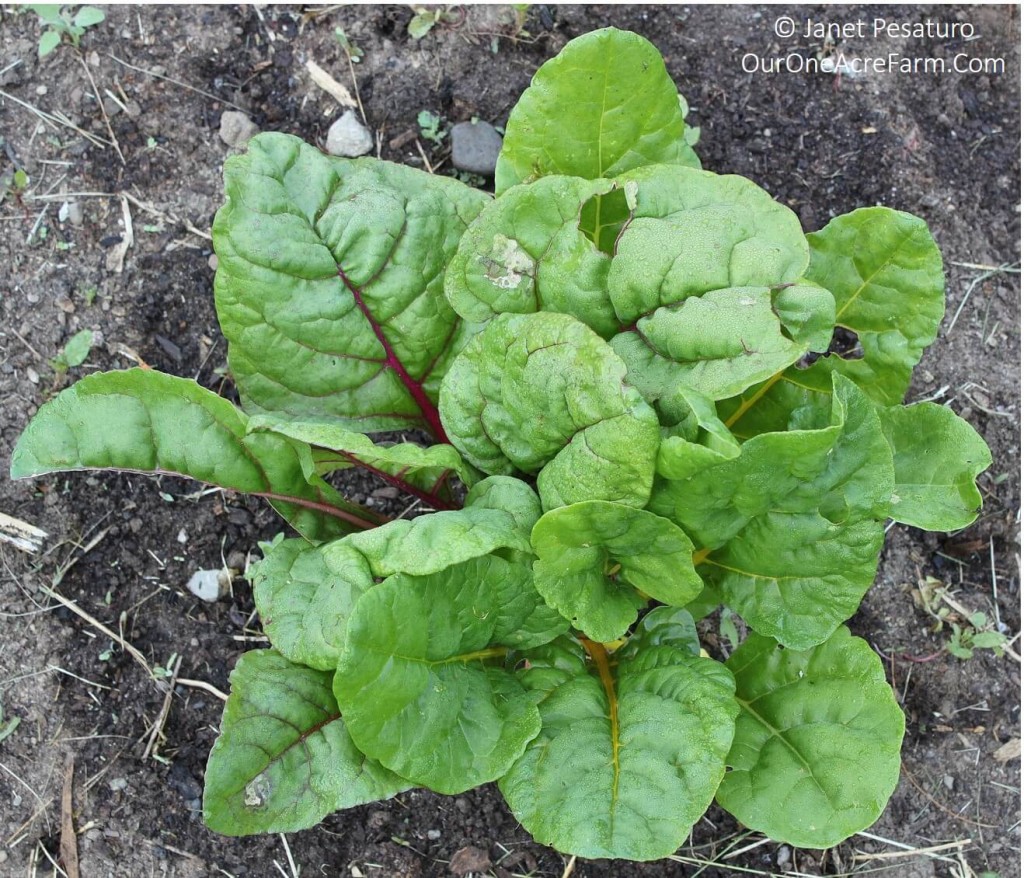
A member of the beet family, Swiss chard produces spring through fall. Use for mesclun in spring, and for cooked dishes summer and fall.
2. Swiss Chard
I grow and harvest Swiss chard the same way I grow and harvest kale and collards: Just set the transplants out as early as possible, and that’s it for planting. No direct seeding. Pick some of the youngest leaves for salads while the weather is still cool, or for as long as you like swiss chard’s flavor and texture in raw salads. Then let the plant grow large, and harvest all summer for cooked greens. This is my least favorite green for raw flavor, but it’s great in soups and frittatas, and, at least in our garden, it’s nearly pest free. If you really want to make it taste good, try Swiss Chard Sauteed with Bacon and Swiss Chard and Risotto.
3. Spinach
Spinach seed can be added to a lettuce seed mix, but I don’t do that because I use it for other things besides salads, and it’s easier to harvest it in quantity if it’s growing separately. Extend the season by setting out transplants and direct seeding as soon as possible. Spinach bolts VERY quickly when the weather warms up, so watch the forecast and harvest aggressively if a heat wave threatens. There are many varieties, but I prefer the flatter leaves, because the don’t collect as much dirt. I like my spinach raw in salads, but it’s also excellent sauteed in butter with garlic, and in quiches, frittatas, and soups. For something more creative, try Spinach Hummus Melts.
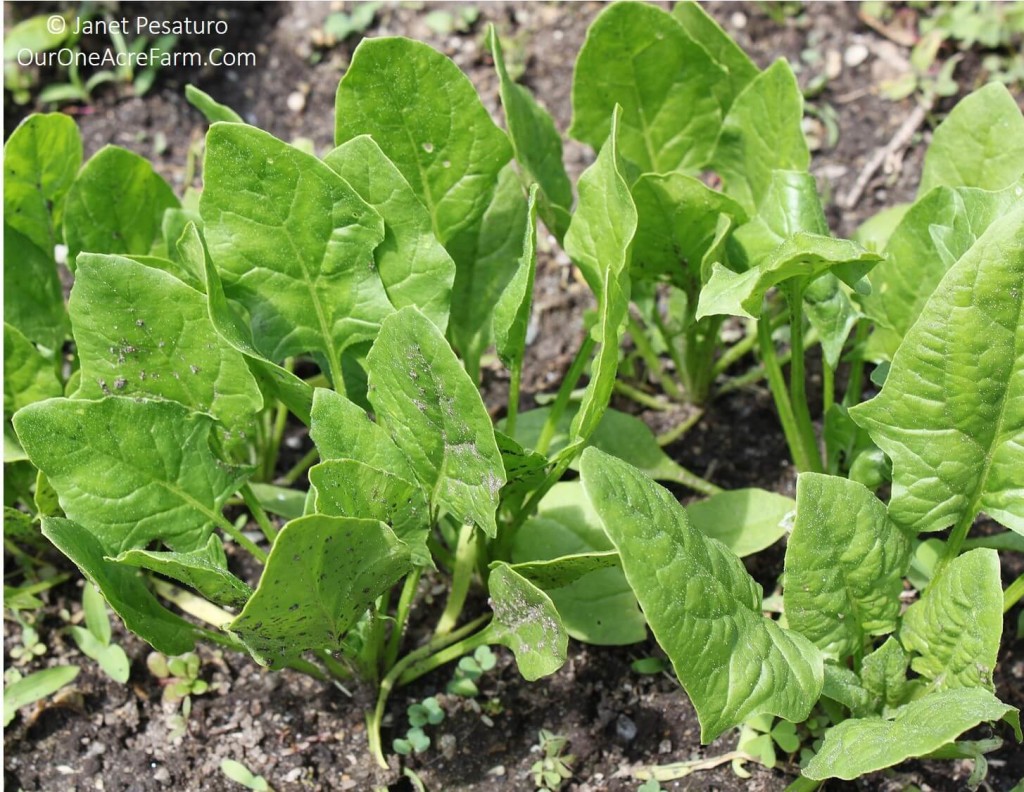
This is a smooth arrowhead leaf spinach, which collects less dirt than the more common savoyed leaf. It’s Flamingo, a very slow bolting variety, which helps extend the season.
Summary of Planting and Harvest Schedule
- 3-4 weeks before you expect your garden soil to be workable, start seeds indoors for lettuces, mustard greens, spinach, arugula, kale, collards, and Swiss chard. Or, buy transplants in time to plant outdoors when soil can be worked.
- As soon as soil can be worked in spring, set transplants in garden and direct seed lettuces and spinach.
- One week later, direct seed mustard greens, arugula, turnips, and beets.
- Sow lettuces, mustard greens, spinach, and arugula every 2 weeks, if desired, until mid-late spring. (Here in Massachusetts, I sow most greens for the last time in early-June. Sometimes I sow arugula a few more times, though its flavor is strong after weather warms.)
- Harvest leaves of lettuces, mustard greens, spinach, and arugula until flavor gets too strong for your taste, or until plant bolts. When you are done harvesting, pull up plants to make room for other crops, leaving some (if desired) to set seed for next year.
- Use leaves of beet and turnip thinnings in salads, leaving the other plants to grow until roots are ready for harvest. When you harvest the roots, use the mature greens in cooked dishes.
- Harvest some of the inner young leaves of kale, collards, and Swiss chard for raw salads, and later in summer, gradually harvest large leaves for cooking and marinated raw slaws. We continue to use young leaves of kale raw in sandwiches all summer long, though they do become tough.
- Sow fall crops of lettuces, mustard greens, and arugula, if you have the time and energy. I’ll be honest, I often run out of steam by then. No need to be a fanatic…
Preserving Greens
Did you know greens can be dried? Dehydration is my favorite way to preserve. Here’s Drying Herbs and Greens.
What kinds of greens do you grow? What are your tops for growing and using greens? Feel free to share your ideas and questions in a comment.
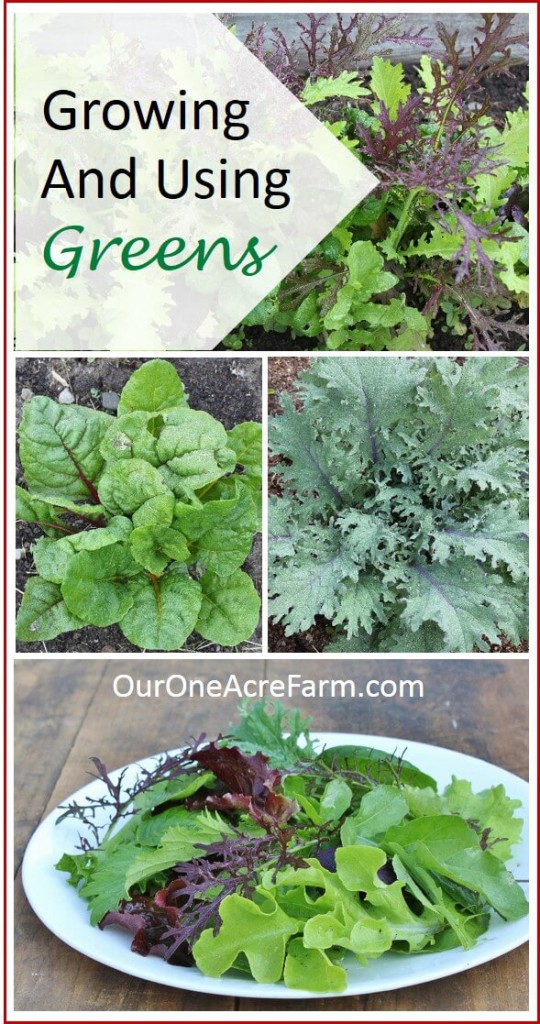
Please pin THIS image.











Great post! Thanks for sharing my arugula and chard recipes.
You are quite welcome, Deb!
I had no idea that lettuce or various greens change in taste depending on weather, time harvested, or growing indoors. This will be my first year growing a gourmet lettuce mix, spinach and kale. I hope they turn out good. I think I’ll try growing greens indoors this winter and see if I mind the “blander” taste. I’d rather more fresh food throughout the winter over more grocery store produce.
BTW- I love that your rabbits introduced you to greens! Neat story. I’m happy for you because greens are seriously one of the healthiest foods out there!
Thanks, Monica. I hope your lettuces, spinach, and kale do beautifully – Bet they will, as they are usually easy to grow.
What a lovely post! I hope it inspires everyone to grow greens! Now do one for melons because I love eating them and hate growing them. Apparently they do NOT thrive on benign neglect. Who knew?
Thanks, Tessa! You’ll have to wait on the melon post, as my results with them have been inconsistent at best. Some years nothing, and other years supplying the school with watermelon.
hi, i live in central coast of calif. can i plant lettuces now with temperatures 80-95 degree weather dierctly in sun or choose some shade to avoid bitterness?
Hi Carolyn, I would definitely give them some shade to keep them cooler. At that temp, though, they’ll probably go to seed fairly quickly even in shade, giving you a short harvest. Try to choose slow bolting varieties – they really do make a difference in warm weather.
going to try lettuce this year…great advice….my chicks are also 4 weeks old and doing great…have had chickens for years and was down to my last two girls and they are seven…what a joy to have chicks again…thanks for the great advice on raising chicks..needed a refresher course!